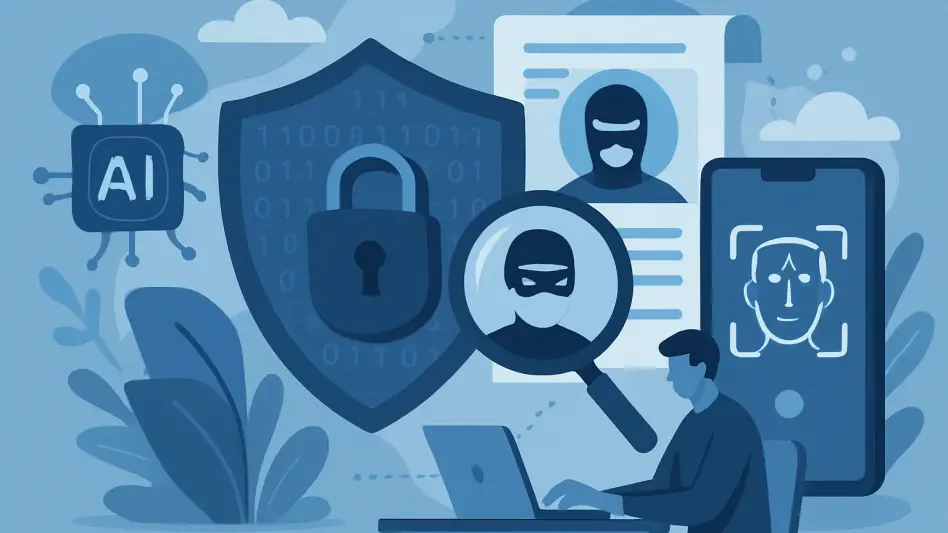In an era where digital transactions underpin global commerce, the specter of fraud looms larger than ever, casting a shadow over industries such as banking, e-commerce, and fintech with threats ranging from identity theft to sophisticated payment scams. As digital interactions multiply, so do the risks, making the need for robust fraud prevention more urgent than ever. This year, a select group of trailblazing companies is stepping up to redefine how fraud is tackled, leveraging cutting-edge technologies to secure digital ecosystems. These innovators are not merely responding to threats after they occur; they are reshaping the landscape with proactive, intelligent solutions that anticipate and neutralize risks before they materialize. From artificial intelligence (AI) and machine learning (ML) to behavioral biometrics, their tools are designed to combat increasingly cunning fraudsters while ensuring seamless experiences for legitimate users. What sets these leaders apart is their ability to address diverse needs—whether for startups or multinational corporations—through specialized, scalable, and compliant systems. This exploration into their groundbreaking work highlights why they are the ones to keep an eye on, offering a glimpse into the future of fraud prevention where technology and strategy converge to outsmart even the most advanced threats.
Emerging Technologies Driving Fraud Defense
AI and Machine Learning Revolution
The backbone of modern fraud prevention lies in the transformative power of AI and machine learning, technologies that empower companies like Feedzai and Featurespace to process billions of data points in real-time. These tools enable a seismic shift from outdated manual monitoring to automated systems that detect patterns and adapt to emerging threats with remarkable speed. By analyzing vast datasets, such platforms identify subtle anomalies that signal fraudulent activity, ensuring businesses stay ahead of sophisticated schemes. This dynamic adaptability is crucial in environments where fraud tactics evolve daily, allowing for immediate responses that protect financial ecosystems without human intervention. The reliance on AI underscores a broader industry trend toward proactive defense, where the sheer scale of digital transactions demands solutions capable of handling complexity at lightning speed.
Beyond detection, AI and machine learning also refine accuracy by minimizing false positives—legitimate transactions mistakenly flagged as fraud—which can erode customer trust if left unchecked. Innovators in this space are fine-tuning algorithms to learn from each interaction, creating systems that grow smarter over time. For instance, the ability to distinguish between a genuine user’s behavior and a fraudster’s subtle deviations is becoming a hallmark of these platforms. This continuous learning process not only bolsters security but also ensures that businesses can scale operations without sacrificing protection. As these technologies mature, they are setting a new standard for fraud prevention, proving that automation is no longer just an option but a necessity for safeguarding digital commerce in high-stakes industries.
Behavioral Biometrics as a Game-Changer
Behavioral biometrics represents a cutting-edge frontier in fraud detection, with companies like BioCatch leading the charge by analyzing over 2,000 user interaction metrics such as typing speed and mouse movements. Unlike traditional methods that rely on static data like passwords, this approach captures the unique ways individuals engage with devices, creating a dynamic profile that is nearly impossible to replicate. When anomalies arise—perhaps a sudden change in how a user navigates an app—the system flags potential fraud without requiring additional input from the user. This invisible layer of security is particularly valuable in banking and fintech, where maintaining a frictionless experience is as critical as preventing losses.
The strength of behavioral biometrics lies in its ability to detect threats that evade conventional systems, such as social engineering attacks or account takeovers by skilled fraudsters. By focusing on subconscious patterns rather than explicit credentials, platforms employing this technology add a robust defense against spoofing attempts that might bypass biometric scans like fingerprints. Moreover, the lack of user interaction means there’s no added burden on customers, preserving satisfaction while enhancing safety. As adoption grows, this method is poised to become a staple in fraud prevention, offering a glimpse into a future where security is both powerful and unobtrusive, seamlessly woven into the digital experience.
Industry-Specific Solutions and Specialization
Tailored Tools for Unique Risks
Fraud threats manifest differently across sectors, prompting innovators like ClearSale and Sardine to craft solutions finely tuned to specific challenges faced by industries such as e-commerce and fintech. ClearSale, for instance, hones in on chargeback protection for online retailers, using a hybrid model of AI and human review to ensure high approval rates for legitimate transactions while blocking fraudulent ones. This targeted approach addresses a pain point unique to digital merchants, where disputed transactions can lead to significant revenue losses. By focusing on the nuances of e-commerce fraud, such platforms deliver precision that broader tools might miss, safeguarding businesses against sector-specific vulnerabilities.
Meanwhile, Sardine tackles the distinct risks in fintech and cryptocurrency spaces, where digital-first environments face threats like unauthorized transfers and account takeovers. Its AI-driven detection and behavioral biometrics cater to the fast-paced, high-risk nature of these transactions, ensuring protection in areas where traditional banking safeguards often fall short. This specialization highlights a growing recognition that fraud prevention must adapt to the unique operational landscapes of different industries. As businesses increasingly seek customized defenses, these tailored solutions prove indispensable, offering not just security but also a competitive edge in niche markets with elevated fraud exposure.
Niche Focus for Maximum Impact
Hawk:AI exemplifies the power of a niche focus by zeroing in on Anti-Money Laundering (AML) compliance for financial institutions, leveraging explainable AI to provide transparency in transaction monitoring. This specialization ensures that flagged activities come with clear justifications, aiding regulatory audits and internal reviews in highly scrutinized sectors. By addressing the specific pain points of AML and related compliance burdens, the platform delivers outsized impact where generic tools might falter, proving that depth can outweigh breadth in regulated environments. Such focused innovation allows banks and similar entities to navigate complex legal frameworks with confidence.
In a similar vein, the emphasis on niche expertise extends to how these tools align with industry priorities, ensuring relevance and effectiveness over time. For financial institutions, the ability to meet stringent global standards while maintaining operational efficiency is non-negotiable, and platforms like Hawk:AI bridge that gap adeptly. This trend toward specialization reflects a broader shift in fraud prevention, where understanding the intricacies of a single sector can yield deeper protections than a one-size-fits-all approach. As threats grow more targeted, the value of such focused solutions becomes ever more apparent, cementing their role in fortifying specific industries against financial crime.
Global Reach and Compliance
Borderless Fraud Protection
In a digital economy without borders, fraud prevention must transcend geographical limits, a challenge met head-on by companies like GBG and Onfido with their extensive global capabilities. These innovators support verification for thousands of identity document types across nearly 200 countries, ensuring businesses can onboard customers securely no matter where they operate. Their systems are built to handle the complexities of international transactions, providing a seamless defense against fraudsters who exploit cross-border vulnerabilities. This borderless approach is vital for enterprises expanding globally, where inconsistent standards and diverse fraud tactics pose constant risks.
Additionally, the ability to adapt to varying cultural and technological landscapes sets these platforms apart in a crowded field. By integrating data from trusted global sources and offering multilingual support, they enable companies to scale without fearing compliance gaps or security lapses. For industries like fintech and e-commerce, where customer bases span continents, this global reach translates into a unified shield against identity theft and payment fraud. As digital commerce continues to erase traditional boundaries, the importance of such comprehensive, worldwide protection cannot be overstated, positioning these innovators as critical allies for any business with international ambitions.
Meeting Regulatory Standards
Compliance with intricate global regulations such as AML and Know Your Customer (KYC) laws forms a cornerstone of fraud prevention, with platforms like Hawk:AI and GBG leading efforts to ensure businesses meet these standards effortlessly. These tools are engineered to align with frameworks like GDPR, providing real-time monitoring and documentation that simplify adherence to legal mandates across jurisdictions. For financial institutions and other regulated entities, this readiness mitigates the risk of penalties while fortifying defenses against financial crimes. The focus on regulatory alignment is not just a feature but a necessity in an era of heightened scrutiny.
Beyond mere compliance, these innovators enhance trust by embedding transparency into their systems, ensuring that businesses can justify actions taken against suspected fraud during audits. This capability is particularly crucial in markets where regulatory landscapes shift rapidly, demanding agility from fraud prevention tools. By offering solutions that preemptively address legal requirements, they allow companies to focus on growth rather than risk management. As global operations become the norm rather than the exception, the role of such compliance-focused platforms in maintaining operational integrity grows, safeguarding both businesses and their customers from the dual threats of fraud and legal repercussions.
Balancing Security and User Experience
Reducing False Positives
One of the most persistent challenges in fraud prevention is striking a balance between stringent security and a smooth user experience, a feat achieved by leaders like ClearSale and BioCatch through innovative approaches. ClearSale employs a hybrid model combining AI with human oversight to minimize false positives—instances where legitimate transactions are incorrectly flagged as fraudulent. This precision is especially critical in e-commerce, where erroneous rejections can drive customers away and dent revenue. By refining detection to focus on genuine threats, such platforms preserve customer trust while upholding robust protection.
Equally important is the impact of reduced false positives on operational efficiency, as businesses avoid the costly process of manually reviewing unnecessary alerts. BioCatch complements this by using behavioral analytics to distinguish between authentic users and fraudsters with minimal disruption, ensuring that security measures don’t alienate customers. This dual focus on accuracy and satisfaction addresses a core tension in fraud prevention, where overly cautious systems can backfire by frustrating users. As digital transactions become more central to commerce, the ability to maintain this balance is what differentiates top innovators, ensuring that security enhances rather than hinders the customer journey.
Frictionless Security Measures
The pursuit of frictionless security is redefining how protection is delivered, with companies like BioCatch and Feedzai excelling at safeguarding users without imposing extra steps. BioCatch’s behavioral biometrics operate invisibly, analyzing user interactions in the background to detect anomalies without requiring passwords or additional verifications. This approach is a boon for industries like banking, where user convenience directly correlates with loyalty. By embedding security into the natural flow of digital interactions, such innovations prove that robust defense need not come at the expense of ease.
Feedzai, on the other hand, leverages real-time transaction monitoring to halt fraud before it impacts users, all while maintaining a seamless interface for legitimate customers. The emphasis on behind-the-scenes protection ensures that businesses can uphold stringent safeguards without slowing down critical processes like payments or account access. This balance is particularly vital in high-volume environments where even minor delays can cascade into significant losses. As expectations for instant, hassle-free digital experiences rise, the ability to deliver invisible yet effective security becomes a defining trait of leading fraud prevention platforms, setting a benchmark for the industry at large.
Scalability and Integration for All Business Sizes
Growing with Enterprises
Scalability stands as a defining strength for innovators like Feedzai and Featurespace, whose platforms are engineered to support massive transaction volumes for large enterprises. Feedzai, for instance, processes billions of data points daily, ensuring that even global financial institutions with complex, high-stakes operations remain protected as they expand. This capacity to handle growth without compromising on speed or accuracy is essential for businesses dealing with escalating digital interactions. Such tools adapt dynamically to increased demand, providing a reliable shield against fraud no matter the scale of operations.
Moreover, the ability to maintain performance under pressure is paired with seamless integration into existing systems, minimizing disruption during deployment. Featurespace’s ARIC Risk Hub, widely used by banks and payment providers, exemplifies this by offering real-time monitoring that scales alongside transaction surges while syncing with enterprise infrastructure. For multinational corporations, this combination of scalability and compatibility ensures that fraud prevention evolves in lockstep with business needs. As digital ecosystems grow more intricate, platforms that can support this expansion while delivering consistent protection are invaluable, cementing their role as trusted partners for industry giants.
Accessible Tools for Startups
For startups and small-to-medium enterprises (SMEs), affordability and simplicity are paramount, and innovators like iDenfy are stepping up with accessible fraud prevention solutions. Offering AI-powered identity verification at a cost-effective price point, iDenfy supports over 3,000 document types and integrates easily via API, allowing smaller businesses to implement top-tier security without straining budgets. This democratization of advanced tools levels the playing field, ensuring that emerging companies aren’t left vulnerable to fraud due to resource constraints. The focus on user-friendly deployment is a lifeline for those with limited technical expertise.
In addition to cost benefits, the accessibility of such platforms lies in their flexibility to cater to modest transaction volumes while still offering robust protection. This adaptability means startups can prioritize growth without fearing fraud-related setbacks, a critical factor in competitive markets. By addressing the unique needs of smaller players, these solutions broaden the reach of sophisticated security measures, proving that innovation in fraud prevention isn’t reserved for corporate giants. As more businesses enter the digital arena, the availability of scalable, budget-friendly tools ensures that comprehensive defense against fraud is within reach for all, fostering a more secure entrepreneurial landscape.
Identity Verification as the First Defense
Stopping Fraud at the Source
Identity verification serves as the first line of defense against fraud, with companies like Onfido and iDenfy leading efforts to secure customer onboarding processes. Onfido supports over 4,500 identity document types across 195 countries, using biometric checks to ensure that individuals are who they claim to be from the outset. This early intervention is crucial in preventing identity theft and account takeovers, which often serve as gateways to broader fraudulent activities. By establishing trust at the entry point, such platforms reduce downstream risks for businesses in sectors like fintech and banking.
The significance of robust onboarding extends beyond mere prevention, as it builds a foundation of confidence for both businesses and their customers. iDenfy complements this by offering affordable verification with video-based KYC processes, ensuring that even smaller firms can implement stringent checks without prohibitive costs. This focus on stopping fraud at the source addresses a critical vulnerability in digital interactions, where compromised identities can lead to cascading financial losses. As fraudsters increasingly target initial access points, the role of identity verification as a proactive barrier becomes ever more vital, shaping a safer digital ecosystem from the very first interaction.
Advanced Biometric Solutions
Biometric verification, including technologies like liveness detection, is a cornerstone of modern identity checks, with innovators like GBG and Onfido at the forefront of this space. GBG’s systems integrate biometric data with global datasets to authenticate users with high precision, catching spoofing attempts that might fool less advanced methods. Liveness detection, which ensures that a real person is present during verification, adds a layer of security against tactics like photo or video manipulation. This advancement is particularly critical in high-risk industries where trust is paramount.
Furthermore, the deployment of biometrics extends to enhancing user confidence, as customers feel reassured by security measures that are both sophisticated and reliable. Onfido’s approach combines facial recognition with document validation, creating a multi-faceted defense that thwarts fraudsters at the earliest stage. This technology not only prevents unauthorized access but also streamlines onboarding by reducing the need for manual reviews. As digital platforms become primary channels for commerce and communication, advanced biometric solutions are proving indispensable, offering a blend of security and efficiency that fortifies the first point of contact against fraudulent incursions.
Proactive Prevention and Predictive Analytics
Staying Ahead of Fraudsters
The transition from reactive to proactive fraud prevention marks a pivotal evolution, with companies like Quantexa harnessing predictive analytics to identify risks before they materialize. By leveraging vast datasets and AI, these platforms forecast potential threats based on historical patterns and emerging trends, allowing businesses to intervene before fraud occurs. This forward-thinking strategy is particularly effective in industries like insurance and banking, where complex schemes can take time to unfold. Staying ahead of fraudsters through anticipation rather than reaction represents a paradigm shift in security.
Proactive prevention also empowers businesses to allocate resources more effectively, focusing on high-risk areas rather than chasing losses after the fact. Quantexa’s ability to integrate real-time data with predictive models ensures that evolving tactics are met with preemptive countermeasures, minimizing financial impact. This approach contrasts sharply with traditional methods that often lag behind sophisticated fraudsters. As threats grow in complexity, the emphasis on foresight through analytics is becoming a defining feature of leading fraud prevention strategies, equipping companies to outmaneuver adversaries in an ever-shifting digital battleground.
Contextual Risk Analysis
Delving deeper into proactive defense, Quantexa’s use of contextual decision-making uncovers hidden risks by analyzing relationships within data, offering insights that surface-level checks might miss. This method maps connections between entities—such as transactions, accounts, and individuals—to reveal fraud networks that operate under the radar. For sectors like government and financial services, where intricate schemes often span multiple layers, this deeper analysis is invaluable. Contextual risk assessment transforms raw data into actionable intelligence, fortifying defenses against elaborate threats.
The power of this approach lies in its ability to provide a 360-degree view of potential vulnerabilities, enabling businesses to address root causes rather than symptoms of fraud, and by linking disparate data points, these systems expose patterns indicative of coordinated attacks. Such attacks may include money laundering or identity fraud rings. This level of granularity not only enhances prevention but also aids in compliance by offering clear evidence for regulatory reporting. As fraud tactics become more interconnected, the role of contextual analysis in anticipating and dismantling such networks grows, positioning it as a critical tool for innovators aiming to stay ahead in the fight against financial crime.








